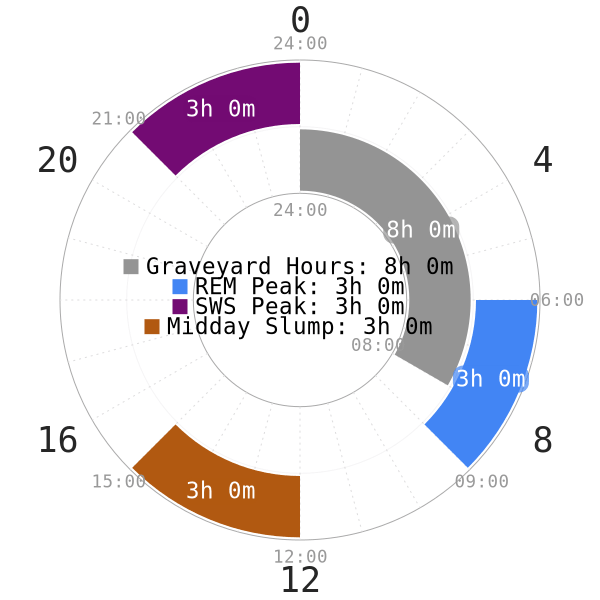Introduction
There are a lot of goals of a polyphasic sleeping lifestyle. However, it is not always about sleep reduction all the time. The maximum wake time per day that 99% of people may achieve is 20 hours. See Minimum Sleep for why this is.
That said, polyphasic scheduling is an experimental art and science serving to increase quality wake time without sacrificing well-being. The essential strategy is increasing the frequency of sleep. The mechanisms are as follow:
- Light sleep’s ability to sustain wakefulness has diminishing returns. This means the more light sleep you get, the less powerful its wakefulness sustaining. On reduced-sleep polyphasic schedules, a nap of 15-25 minutes can keep you fresh for 4-8 hours (possibly less during adaptation); this also depends on the length of supporting core(s) and time of day.
- On Everyman 1, a single nap might keep you alert up to maximum 11-12 hours until your bedtime.
- On Dual Core 1, a single nap might keep you going for 8 hours maximum.
- With monophasic sleep, it takes 4+ hours of light sleep to sustain wakefulness for an entire day. Even then, there is a well known circadian dip1 in alertness around 12:00-15:002–4.
- Recent ideas suggest that the diminishing wakefulness sustaining is not actually a result of a reduction of light sleep, but because of increased adenosine levels. Learn more here.
Maximize alertness by sleeping when sleepy enough often fits into certain circadian spots. These include the SWS peak for some (21:00-midnight), the “graveyard” hours for most (midnight-08:00), and the midday slump for most (by 15:00).
Increase Wake Time and Quality

- Higher frequency of sleep sustains more alertness per sleep time.
- The brain adapts by learning to prioritize SWS and REM in shortened sleeps.
- Conducive sleep spots are most likely SWS peak for some (21:00-midnight) and “graveyard” hours for most (midnight-8am).
- Minimum sleep per day is 4 hours for almost everyone. These are people who do not possess any genetic mutations (most notably DEC25 or severe environmental pressures (see the Piraha tribe).
- Minimize sleep inertia for adaptability (no SWS wakes, avoid REM wakes). 90 minute cycles, or 20 minute naps.
- Ultradian rhythm/BRAC
Improve Sleep Quality
- The dark period
- Rem and SWS peaks
- Midday circadian dip
- Removing drugs, caffeine, and alcohol, which interfere with sleep quality.
- SOREM in naps. Avoid SOSWS in naps.
- Separate sleeps by at least 2-3 hours, depending on the schedule.
Sleep Duration Matters
The duration of each sleep session is specific because sleep happens in cycles. In general, a sleep cycle is about 90 minutes, but sometimes as long as 120 minutes or short as 80 minutes. These values depend on many factors, including person-to-person differences6. Cycle lengths also vary on a daily basis. See Sleep Cycle for more information regarding sleep architecture.
Adaptation to polyphasic sleep involves fitting more SWS and REM into less time, by reducing total light sleep. However, this process may not fully apply to non-reducing polyphasic schedules. Otherwise, when there is sleep reduction, there is an increase in SWS and REM within each cycle. In return, each cycle duration decreases. Cycle lengths may become as short as 80m, or even about 60 minutes in extreme cases with frequent sleeps.
Two Ideal Scenarios
- On the first cycle, one often goes through light sleep before entering deep sleep around 25 minutes. Thus, 20 minutes naps take advantage of this window. With naps, SOREM can appear in this light sleep buffer window before SWS arrives.
- Right at the beginning of a new cycle during the light sleep stage. Core sleeps with multiples of 90 minute cycles are generally safe durations to enjoy these easier wake points on polyphasic sleep. However, as adaptation goes on, it likely still takes a lot of efforts to wake up for any sleep durations.
These will ideally minimize sleep inertia to maximize alertness and productivity. Generally, the light sleep after an SWS block will still be a bit more difficult/unpleasant to wake from than light sleep after REM.
Main authors: Crimson & Aethermind
Page last updated: 2 April 2021
Reference
- Barnes CM. The Ideal Work Schedule, as Determined by Circadian Rhythms. Harvard Business Review. https://hbr.org/2015/01/the-ideal-work-schedule-as-determined-by-circadian-rhythms. Published January 28, 2015. Accessed December 9, 2018.
- Campbell SS. Duration and Placement of Sleep in a “Disentrained” Environment. P. 1984;21(1):106-113. doi:10.1111/j.1469-8986.1984.tb02327.x. [PubMed]
- Stahl M, Orr W, Bollinger C. Postprandial sleepiness: objective documentation via polysomnography. Sleep. 1983;6(1):29-35. [PubMed]
- Nakagawa Y. Continuous observation of EEG patterns at night and in daytime of normal subjects under restrained conditions. I. Quiescent state when lying down. E. 1980;49(5-6):524-537. doi:10.1016/0013-4694(80)90395-8. [PubMed]
- Smith D. Scientists Discover How Gene Mutation Reduces the Need for Sleep. UC San Francisco. https://www.ucsf.edu/news/2018/03/410051/scientists-discover-how-gene-mutation-reduces-need-sleep. Published April 16, 2018. Accessed December 9, 2018.
- Brandenberger G, Ehrhart J, Piquard F, Simon C. Inverse coupling between ultradian oscillations in delta wave activity and heart rate variability during sleep. Clin Neurophysiol. 2001;112(6):992-996. [PubMed]
